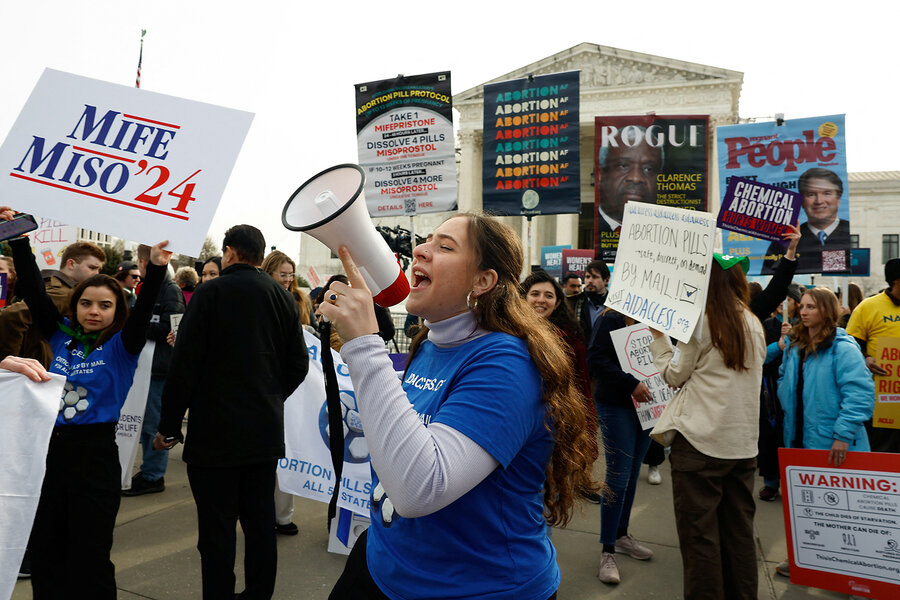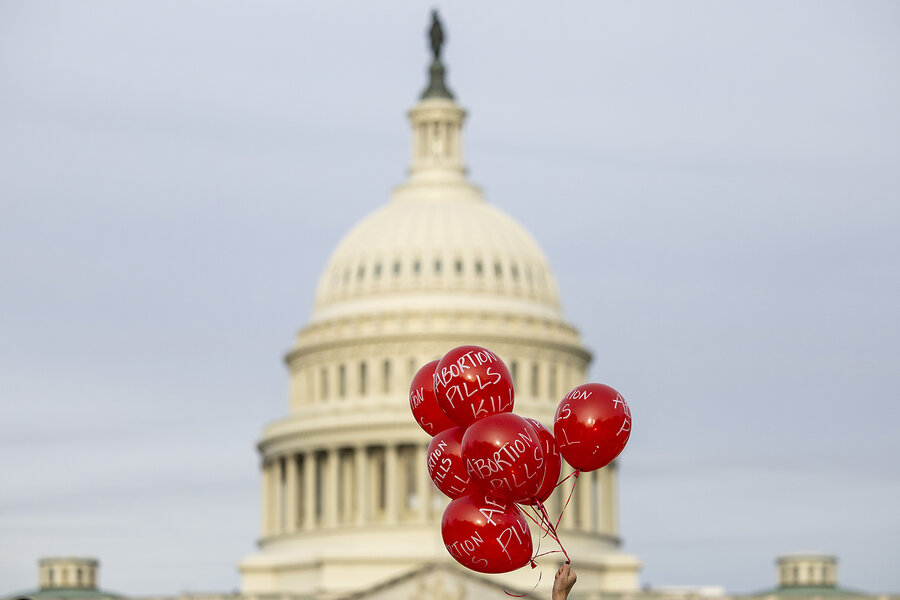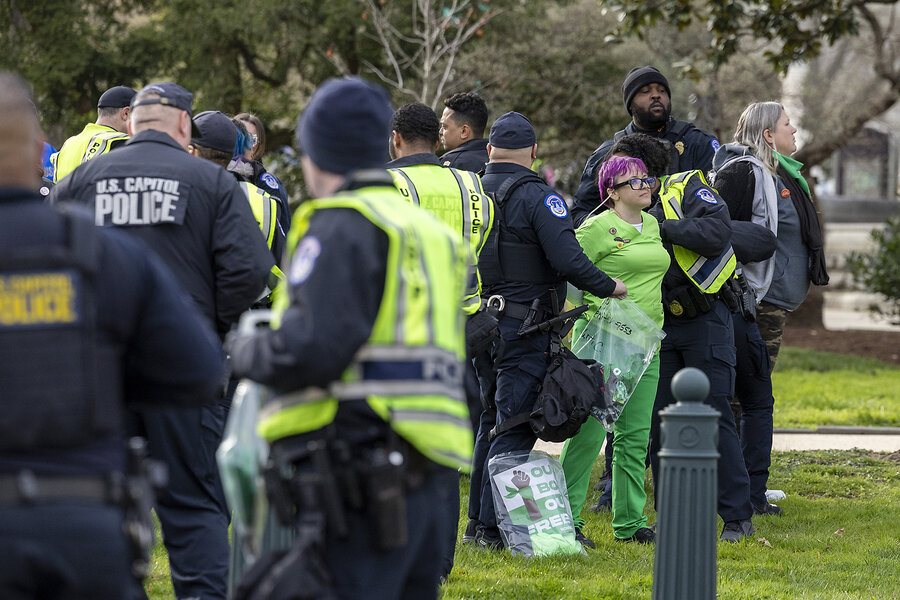Wary Supreme Court voices skepticism about abortion pill case
Loading...
On Tuesday, the Supreme Court of the United States heard its biggest abortion case since it overturned Roe v. Wade two years ago. And for the most part, the justices appeared skeptical that they should even be hearing the case at all.
In one of the most high-profile cases of what has become a blockbuster Supreme Court term, the justices are being asked to review a lower court ruling restricting access to mifepristone, a pill used in almost two-thirds of abortions.
Why We Wrote This
Who has the right to bring a case before the Supreme Court? The justices brought up the question of “standing” repeatedly during Tuesday’s abortion pill case.
The case stems from two lawsuits filed by a coalition of anti-abortion physicians and organizations – against the U.S. Food and Drug Administration and the drug’s manufacturer, respectively. The legal questions in the case focus on the safety of mifepristone and how it’s been regulated.
During oral argument on Tuesday, however, the justices focused most of their questions on standing. Standing is a threshold doctrine that says that to bring a case, a party must show it has suffered a concrete injury. A majority of the court seemed to question whether the mifepristone lawsuits fall within those limits.
“Standing would be an easy way to avoid deciding the substance of the case,” says Elizabeth Sepper, a professor at the University of Texas at Austin School of Law.
On Tuesday, the Supreme Court of the United States heard its biggest abortion case since it overturned Roe v. Wade two years ago. And for the most part, the justices appeared skeptical that they should even be hearing the case at all.
In one of the most high-profile cases of what has become a blockbuster Supreme Court term, the justices are being asked to review a lower court ruling restricting access to mifepristone, a pill used in almost two-thirds of abortions.
At least compared with the case two years ago, Dobbs v. Jackson Women’s Health, the stakes appear lower. However the court rules, mifepristone is going to stay on the market. The ruling likewise won’t affect the spectrum of state laws around the country regulating, or banning, abortions.
Why We Wrote This
Who has the right to bring a case before the Supreme Court? The justices brought up the question of “standing” repeatedly during Tuesday’s abortion pill case.
But in a post-Roe America, medication abortion has become more common, and this case has significant implications for that form of terminating a pregnancy.
The case stems from two lawsuits filed by a coalition of anti-abortion physicians and organizations – against the U.S. Food and Drug Administration and the drug’s manufacturer, respectively. The legal questions in the case focus on the safety of mifepristone and how it’s been regulated.
The parties present strikingly conflicting views of the drug’s safety record, but during oral argument on Tuesday, the justices focused most of their questions on standing. Standing is a threshold doctrine that says that to bring a case, a party must show it has suffered a concrete injury. A majority of the court seemed to question whether the mifepristone lawsuits fall within those limits.
“This case seems like a prime example of turning what could be a small lawsuit into a nationwide legislative assembly on an FDA rule or any other federal government action,” noted Justice Neil Gorsuch.
If the justices side with the anti-abortion physicians, the Biden administration and medical experts have said, it could have a chilling effect on drug research and development in the U.S. far beyond the issue of abortion.
“Standing would be an easy way to avoid deciding the substance of the case,” says Elizabeth Sepper, a professor at the University of Texas at Austin School of Law.
Abortion in a post-Roe U.S.
The Supreme Court’s overturning of Roe reshaped America’s abortion landscape. Two years later, 21 states have enacted laws either banning abortion or restricting it more than Roe allowed, according to The New York Times.
The number of Americans getting abortions has increased, and where and how Americans obtain abortions has changed. Medication abortions accounted for 63% of all abortions in 2023, up from 53% in 2020, according to the Guttmacher Institute, a research and policy organization that supports expanding reproductive rights. In that time period, the total number of abortions in the U.S. also increased by 10%, according to another Guttmacher study.
That context in particular makes this “the most important abortion case since” the court overturned Roe, says Cathren Cohen, a staff attorney at the UCLA Law Center on Reproductive Health, Law, and Policy.
“People will find a way to get the care they need. And the availability of these pills has put us in an entirely different scenario than before Roe,” she adds. “What an ‘illegal abortion’ looks like now is much safer.”
The FDA first approved mifepristone in 2000. It loosened regulations around its use in 2016 and again in 2021. Patients once had to take the drug in a physicians’ office before the eighth week of pregnancy. They now can have it prescribed via a telehealth appointment, receive it in the mail, and take it at home in the first 10 weeks of pregnancy.
In its lawsuits, the anti-abortion coalition claims that the FDA was too hasty with its approvals, overlooking serious medical problems that can arise from the looser regulations.
“As long as abortion is legal, we want it to be as safe as possible for the women who are using – and the girls who are using – the abortion pill,” says Sarah Parshall Perry, a senior legal fellow with The Heritage Foundation, a conservative think tank that is not involved in the legislation.
“Abortion is not at stake here,” she adds. “It is whether or not we want all federal agencies to follow federal law when they make regulations that affect millions and millions of Americans.”
Lawyers for the FDA and the drug manufacturer, meanwhile, cited multiple studies they said show that mifepristone is very safe, and in fact, has fewer adverse effects than Tylenol.
A district court judge in Texas and the U.S. Court of Appeals for the Fifth Circuit both ruled that the FDA’s actions were “arbitrary and capricious.” Both courts issued nationwide orders – the district court to take the drug off the market entirely, the appeals court to return mifepristone access to its pre-2016 state.
But from the beginning, legal experts questioned whether they should have allowed the case to proceed at all. On Tuesday, a majority of justices joined that chorus of skepticism.
The “squishy” standing doctrine
Standing doctrine holds that to bring a lawsuit in federal court, you must first prove that you’re suffering, or would suffer, a clear and concrete harm that the courts can abate. Tradition then holds that courts should provide the narrowest relief possible.
In this case, both lower courts agreed that the physicians have standing because they’ve had to, and with “statistical certainty” will continue to have to, give emergency care to women who experience complications after taking mifepristone.
The concerns about that analysis that some justices voiced Tuesday fell broadly into two buckets: One, that the group didn’t show enough of a clear and concrete injury to achieve standing. And two, that the remedy the group is seeking is too broad.
“I’m worried that there is a significant mismatch in this case between the claimed injury and the remedy that’s being sought,” said Justice Ketanji Brown Jackson.
“Because [the physicians] object to having to be forced to participate in this procedure, [they’re] seeking an order preventing anyone from having access to these drugs at all,” she added. “I’m just trying to understand how they could possibly be entitled to that given the injury that they have alleged.”
Justice Samuel Alito, one of the court’s most conservative members, countered that the FDA shouldn’t be able to issue regulations with legal impunity.
“Maybe what [the FDA] did was perfectly lawful, but shouldn’t somebody be able to challenge that in court?” he asked Elizabeth Prelogar, the U.S. solicitor general.
Judges, justices, and legal scholars over the years have chimed in on how “squishy” standing doctrine can be, and Chief Justice John Roberts did so here.
Supreme Court precedents “talk about requiring a substantial risk that harm will occur,” he said. “How are we supposed to find the spot at which the risk becomes substantial? ... What percentage of adverse consequences would be enough?”
But the standing arguments, and lower court rulings, in this case are part of a broader trend, noted Justice Gorsuch, another of the court’s more conservative members. In the 12 years Franklin D. Roosevelt served as president, federal courts didn’t issue a single universal injunction, he noted. Over the past four years, “that number is something like 60.”
“We’ve had, one might call it, a rash of universal injunctions” recently, he added.
Both Justice Alito and Justice Clarence Thomas observed during the argument that the FDA rule allowing mifepristone to be delivered by mail could violate the Comstock Act, an 1873 law that banned the mailing of abortion drugs or devices. Based on the oral argument, it doesn’t appear that a majority of the court shares that view, however.
It’s unclear how the Supreme Court will decide this case. The oral argument suggests that even the court that overturned Roe may be reluctant to endorse these legal arguments for the sake of restricting abortion access.
“It’s always been the case that standing is the easy way out” of difficult and potentially divisive cases, says Professor Sepper. “And it’s always been the case that conservatives on the court have fairly rigid notions of what it takes to have standing.”









